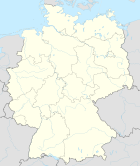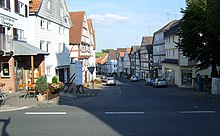Rauschenberg
| coat of arms | Germany map | |
|---|---|---|

|
Coordinates: 50 ° 53 ' N , 8 ° 55' E |
|
| Basic data | ||
| State : | Hesse | |
| Administrative region : | to water | |
| County : | Marburg-Biedenkopf | |
| Height : | 227 m above sea level NHN | |
| Area : | 67.33 km 2 | |
| Residents: | 4408 (Dec. 31, 2019) | |
| Population density : | 65 inhabitants per km 2 | |
| Postal code : | 35282 | |
| Primaries : | 06425, 06427 | |
| License plate : | MR, BID | |
| Community key : | 06 5 34 017 | |
| City structure: | 7 districts | |
City administration address : |
Schlossstrasse 1 35282 Rauschenberg |
|
| Website : | ||
| Mayor : | Michael Emmerich ( CDU ) | |
| Location of the town of Rauschenberg in the Marburg-Biedenkopf district | ||
Rauschenberg is a town in the north of the central Hessian district of Marburg-Biedenkopf .
geography
Geographical location
Rauschenberg is located on the southeast edge of the Burgwald , northeast of Marburg and north of Kirchhain . The Wohra flows through some parts of the community .
Neighboring communities
Rauschenberg borders in the north on the town of Rosenthal ( Waldeck-Frankenberg district ) and the communities Wohratal (Marburg-Biedenkopf district) and Gilserberg ( Schwalm-Eder district ), in the east on the town of Stadtallendorf , in the south on the town of Kirchhain , in the southwest to the municipality of Cölbe , and in the west to the city of Wetter (all in the Marburg-Biedenkopf district).
City structure
Rauschenberg consists of the districts of Albshausen , Bracht , Ernsthausen , Josbach , Rauschenberg, Schwabendorf and Wolfskaute .
history
As early as around the year 1000, the Rauschenberg Castle was built in today's Rauschenberg area , and the settlement developed under its protection. The Rauschenberg settlement was almost completely destroyed by fire on May 8, 1266. Count Gottfried V. von Ziegenhain granted the place special powers to rebuild and on May 25, 1266 granted it city rights . Rauschenberg was the seat of the Rauschenberg office . When the counts of Ziegenhain died out in 1450, the county of Ziegenhain and with it the castle and town of Rauschenberg fell to the Landgraviate of Hesse . Soon afterwards the castle was expanded to become a hunting lodge.
The remains of Hundsbach Castle are in the Hundsbach Valley near Ernsthausen .
During the Thirty Years War Rauschenberg was sacked by Swedish troops. After the castle was blown up two years before the end of the war as part of the War of the Hessian Succession at the behest of a Kassel colonel, only a ruin remains there today.
At the time of the Napoleonic Kingdom of Westphalia 1806-1813, Rauschenberg was the administrative seat of the canton of Rauschenberg . The district court of Rauschenberg existed until 1932 .
Incorporations
As part of the regional reform in Hesse , the state government approved the merger of the city of Rauschenberg and the municipalities of Albshausen, Bracht, Ernsthausen, Josbach, Schwabendorf and Wolfskaute in what was then the district of Marburg to form a city with the name Rauschenberg with effect from December 31, 1971 .
Franz Berthoud
At the time of National Socialism , Franz Berthoud (1894–1977) worked as a pastor at the town church in Rauschenberg. He was a committed opponent of National Socialism . He and his wife were one of the few who refused to vote for the NSDAP in 1933 . When this became public knowledge, he got into trouble with the local SA and came under pressure. This intensified when Berthoud visited a dying Jew in the neighborhood in 1934. This process - documented in the parish archives as the "Plaut case" - led to a serious internal church conflict, first with the church council, but then also with the regional church leadership in Kassel. Berthoud remained steadfast, was actively involved as chairman of the Confessing Church in the Kirchhain parish and, despite all legal persecutions and denunciations, remained loyal to his parish beyond the war. In 1956 he left the pastor's post for health reasons and worked as a pastor in Hofgeismar and later in Ottrau , where he died in 1977.
politics
City Council
The local elections on March 6, 2016 produced the following results, compared to previous local elections:
| Parties and constituencies |
% 2016 |
Seats 2016 |
% 2011 |
Seats 2011 |
% 2006 |
Seats 2006 |
% 2001 |
Seats 2001 |
||
|---|---|---|---|---|---|---|---|---|---|---|
| CDU | Christian Democratic Union of Germany | 26.1 | 6th | 32.0 | 7th | 32.9 | 8th | 30.7 | 7th | |
| SPD | Social Democratic Party of Germany | 23.1 | 5 | 28.2 | 7th | 36.4 | 8th | 38.8 | 9 | |
| FBL | Free list of citizens | 29.7 | 7th | 20.2 | 5 | 20.4 | 5 | 20.8 | 5 | |
| GREEN | Alliance 90 / The Greens | 21.1 | 5 | 19.5 | 4th | 10.4 | 2 | 9.8 | 2 | |
| total | 100.0 | 23 | 100.0 | 23 | 100.0 | 23 | 100.0 | 23 | ||
| Voter turnout in% | 51.4 | 51.4 | 52.4 | 58.8 | ||||||
coat of arms
The city of Rauschenberg was approved by the Hessian Minister of the Interior on May 16, 1990 for the coat of arms described below.
- Description of coat of arms
- "The coat of arms of the city of Rauschenberg shows a six-pointed silver star in the shield divided by black and gold."
meaning
The coat of arms corresponds to that of the Counts of Ziegenhain , the former lords of the city. The Hessisches Ortswappenbuch from 1956 (Verlag CA Starke, Limburg) shows an eight-pointed star. This reminds us that Elisabeth, the widow of the last Ziegenhain Count Johann II. , Was a born Countess von Waldeck who invested a lot in Rauschenberg (e.g. in the town church); the eight-pointed star is the Waldeck black star on a yellow background.
Town twinning
The twin town of Rauschenberg is Westende in Belgium .
Culture and sights
Buildings
In the old town of Rauschenberg, especially in the center around the town hall, there are many half-timbered houses several hundred years old in good condition.
After the destruction in the Thirty Years' War, only small remains of the castle or palace Rauschenberg remain. The ruins on the hill above the old town of Rauschenberg are freely accessible.
The town church in Rauschenberg is also worth mentioning. The oldest part, especially the western main nave, dates from the middle of the 13th century. Around 1450 the church was enlarged (including a late Gothic choir) and equipped with a late Gothic altarpiece that is well worth seeing. The former winged altar - probably from the school of Konrad von Soest - is very similar to the famous Bad Wildunger altarpiece, but is no longer completely preserved. Some of the pictures are missing in the middle. The crescent moon Madonna with child, which is also dated to the beginning of the 15th century, may have stood in the center on the north side wall.
Below the town church is the former vicarage from the 16th century called "Metropolitanei" and down the valley the castle-like Burgmannenhaus, also from the 16th century, until 1812 the residence of the Rauschenberg Burgmannen.
Economy and Infrastructure
traffic
- Rauschenberg is connected to the road network via the federal highway 3 Frankfurt / Kassel and the state roads L3073 and L3077.
- In public transport there are bus connections to and from Kirchhain and Marburg several times a day. Rauschenberg was connected to the rail network (Kirchhain – Gemünden route) with the Wohratalbahn . In 1972 passenger traffic was discontinued, in 1981 goods traffic was discontinued and the line was closed and completely dismantled in 1982.
Industry and Commerce
Immediately to the east below the core town of Rauschenberg, directly adjacent to the Wohra , is an industrial park in which various medium-sized and small businesses are located.
Personalities
Personalities born in Rauschenberg
- Johannes Hinderbach (1418–1486), Bishop of Trento
- Johann Ludwig Konrad Allendorf (1693–1773), educator, Lutheran pastor and poet of hymns
- Heinrich Grebe (1831–1903), geologist
- Gustav Simon (1878–1962), administrative lawyer
Personalities who lived or worked in Rauschenberg
- Johann Spieker (1756–1825), pastor in Rauschenberg
- Franz Berthoud (1894–1977), Reformed theologian and pastor at the town church in Rauschenberg
- Peter Janich (1942–2016), philosopher and co-founder of methodical culturalism, died in Rauschenberg
literature
- Kurt Engel & Theresia Jacobi: Historical city guide Rauschenberg
- 725 years of the city of Rauschenberg: 1266–1991; Festival week from June 29th to July 8th 1991; Released 1991
Web links
- Official city homepage
- Illustration by Daniel Meisner from 1624: Raúschenberg; Lætitia Et Honestate ( digitized version )
Individual evidence
- ↑ Hessian State Statistical Office: Population status on December 31, 2019 (districts and urban districts as well as municipalities, population figures based on the 2011 census) ( help ).
- ↑ Martin Röhling: The story of the counts of Nidda and the counts of Ziegenhain. (Niddaer Geschichtsblätter booklet 9) Niddaer Heimatmuseum e. V., Nidda, 2005, ISBN 3-9803915-9-0 (p. 33)
- ↑ municipal area reform in Hesse; Mergers and incorporations of municipalities from December 20, 1971 . In: The Hessian Minister of the Interior (ed.): State Gazette for the State of Hesse. 1972 No. 2 , p. 47 , point 50 para. 2 ( online at the information system of the Hessian state parliament [PDF; 4.8 MB ]).
- ^ Gernot Schulze-Wegener: Pastor Franz Berthoud (1894–1977); A life between adjustment and resistance. In: Hessisches Pfarrblatt , June 2012, editor and publisher: Ev. Pastors' Association in Hesse and Nassau e. V., Frankfurt, and Parish Association Kurhessen-Waldeck, Marburg (p. 56–64) (PDF; 242 kB)
- ^ Result of the municipal election on March 6, 2016. Hessian State Statistical Office, accessed in April 2016 .
- ^ Hessian State Statistical Office: Result of the municipal elections on March 27, 2011
- ^ Hessian State Statistical Office: Result of the municipal elections on March 26, 2006
- ↑ Approval of a coat of arms of the city of Rauschenberg, Marburg-Biedenkopf district from May 16, 1990 . In: The Hessian Minister of the Interior (ed.): State Gazette for the State of Hesse. 1990 No. 23 , p. 1036 , point 527 ( online at the information system of the Hessian state parliament [PDF; 5.5 MB ]).









